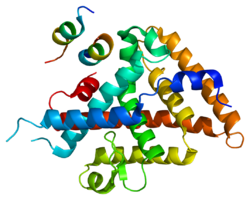The liver receptor homolog-1 (LRH-1) also known as totipotency pioneer factor NR5A2 (nuclear receptor subfamily 5, group A, member 2) is a protein that in humans is encoded by the NR5A2 gene. [5] [6] LRH-1 is a member of the nuclear receptor family of intracellular transcription factors.
LRH-1 plays a critical role in the regulation of development, cholesterol transport, bile acid homeostasis and steroidogenesis. [7] [8] [9] [10]
LRH-1 is important for maintaining pluripotence of stem cells during embryonic development. [11] [10]
Nr5a2 was recently identified at a totipotent pioneer factor. [10] The orphan nuclear receptor Nr5a2 has been shown to be important in fertility, ovarian function, [12] and zygotic genome activation (ZGA). [10] Heterozygosity for Nr5a2 is associated with reduced ovarian function, specifically in the synthesis of progesterone. This impaired progesterone production was associated with infertility in female mice, as well as increased incidence of pregnancy loss. [12] The loss of embryos around implantation associated with Nr5a2+/- mice indicated a possible interaction with genome-wide gene expression in early embryo development. Upon further investigation, Nr5a2 was found to regulate ZGA in mice embryos similar to that of Zelda in Drosophila. Nr5a2 is maternally contributed and regulates transcription activity in the early embryo by binding to distal cis-regulatory sequences and promoting chromatin accessibility. The change in chromatin conformation allows for the activation of transcription of about 72% of genes involved in ZGA. [10]









